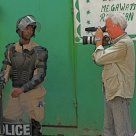WATCH ABOVE: A preview for 16×9’s “Resurrecting Species.”

Imagine a nesting site over three times the size of the City of Toronto, an immense blanket of passenger pigeons. Once aloft, after stripping the forest of acorns, the flock would be visible from the International Space Station. A “feathered river across the sky,” is what author Joel Greenberg called it. Someone else described it as a “biological storm.”
River or storm, it’s something nobody alive today has ever seen. But Major John Ross, a hunter and naturalist, claims to have witnessed this wonder of nature in 1860, near the site of today’s Niagara-on-the-Lake. The flock overhead was 300 miles long, he calculated, and a mile wide. Someone did the math: two birds for every square yard, flying at a speed of 60 miles an hour. That comes out to roughly 3.17 billion birds.
Named after the French word “passager” for “passing by,” the passenger pigeons were masters of the sky. They made up nearly 40% of North America’s entire bird population.
READ MORE: Can DNA sequencing bring extinct species back to life?
But a half century later they were gone. They were captured in nets, blown out of the skies with shotguns and knocked out of trees with poles. Hunters lured the birds with traps, hence the term “stool pigeon.” Eaten in pies, they fed a generation. The French called the bird a tourte, prompting the belief that it was the favoured ingredient for the original Quebecois tourtiere.
- What is a halal mortgage? How interest-free home financing works in Canada
- Ontario doctors offer solutions to help address shortage of family physicians
- Capital gains changes are ‘really fair,’ Freeland says, as doctors cry foul
- Budget 2024 failed to spark ‘political reboot’ for Liberals, polling suggests
Most North Americans know about the demise of the buffalo. But the disappearance of the passenger pigeons was even more epic. (The speed of the extinction was too much for some to believe: One theory held that they flew into the Bermuda Triangle.)
The last specimen was named Martha who died, alone and childless, on Sept. 1, 1914—exactly 100 years ago. Her obituary is that of a species. When she dropped dead off her perch at the Cincinnati Zoo, they shipped her to the Smithsonian in an ice cube, where she was stuffed.
They say Martha was grumpy and unresponsive in her old age. Little wonder, considering how her species was treated. But naturalists had a soft spot for the elegant, russet-breasted bird. There are 1,532 stuffed specimens in the world, many of them lying in orderly ranks in museum cabinets. They are quite beautiful in death.
Toronto’s Royal Ontario Museum has 10 per cent of the total, including a robust specimen called Passenger Pigeon 1871—named after the year she was shot by a Toronto hunter. The ROM’s resident ornithologist, Mark Peck, snipped a tiny fragment of the bird’s toe-pad and shipped it off to Novak’s California lab.
“There’s enough DNA in that sample,” says Peck, “that they’re able to extract the entire genome of this pigeon from that small piece of skin off the toe. Even though it is 140 years old.”
They go back at least as far as the pyramids. In his ultra-secure lab at the University of California, Santa Cruz, Ben Novak has the bones of passenger pigeons that are 4,000 years old and are still able to retrieve the DNA!
But the question has to be asked: Is the resurrection of the pigeon a good idea? Allan Baker, who heads the natural history department at the ROM, thinks not. “I have a lot of problems with this,” he says. “Would we put specimens of the reborn birds in a zoo. If they came back in huge numbers, would they not devastate our crops? Could they be carriers of new kinds of diseases?”
“Perhaps we should realize that extinction and speciation are a natural process,” Baker concludes. “I think the investment would pay dividends far better in trying to save a lot of these endangered populations that have a chance to not go extinct.”
In other words, should we accept extinction as part of the cycle of life? Martha making room for other species more adaptable to the times?
“Resurrecting Species” airs this Saturday on 16×9.




Comments